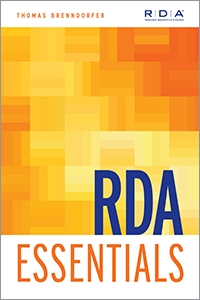
RDA Essentials
For UK or EU purchases, contact Facet Publishing to order. For all other purchases outside the United States, please consult our International Orders page.
Primary tabs
You don't need to be an ALA Member to purchase from the ALA Store, but you'll be asked to create an online account/profile during checkout to proceed. This Web Account is for both Members and non-Members. Note that your ALA Member discount will be applied at the final step of the checkout process.
If you are Tax-Exempt, please verify that your account is currently set up as exempt before placing your order, as our new fulfillment center will need current documentation. Learn how to verify here.
- Description
- Table of Contents
- About the author
- Reviews
This concise guide to cataloging with RDA: Resource Description and Access specifically hones in on the needs of those seeking a simplified path to creating basic RDA records. First describing foundational RDA concepts and vocabulary, Brenndorfer then distills RDA instructions, matching them to cataloging practice in easy-to-follow language. Current with RDA instructions through the April 2015 update to RDA, this guide makes an excellent primer while also serving as a bridge to more complex cataloging. It's an ideal resource for:
- Small libraries that require standard cataloging but don't need all the details of structure and content of the full RDA
- LIS students who need an introduction to cataloging
- Paraprofessionals seeking a ready reference for copy cataloging
- Experienced catalogers needing a quick summary of RDA practice
A handy offline access point for solo and part-time catalogers, Brennndorfer's guide also supports training and classroom use in any size institution.
Introduction
Section 1: Elements
Chapter 1: Identifying Manifestations and Items
Mode of Issuance
Titles
Statements of Responsibility
Edition Statements
Numbering of Serials
Production, Publication, Distribution, and Manufacture Statements, and Copyright Date
Series Statements
Frequency, Identifiers, and Notes
Item Elements
Chapter 2: Describing Carriers
Media Type and Carrier Type
Extent
Dimensions
Specialized Elements
Elements for Sound, Projection, Video, and Digital File Characteristics
Notes
Chapter 3: Providing Acquisition and Access Information Elements
Chapter 4: Identifying Works and Expressions
Work Elements
Expression Elements
Chapter 5: Describing Content
Work Elements
Expression Elements
Chapter 6: Identifying Persons
Preferred Name for the Person
Variant Names and Other Elements
Chapter 7: Identifying Families
Preferred Name for the Family
Variant Names and Other Elements
Chapter 8: Identifying Corporate Bodies
Preferred Name for the Corporate Body
Variant Names and Other Elements
Chapter 9: Relationships between Entities
Chapter 10: Relationships to Persons, Families, and Corporate Bodies Associated with a Resource
Relationship Elements
Chapter 11: Relationships between Works and Subjects
Relationship Elements
Chapter 12: Relationships between Works, Expressions, Manifestations, and Items
Relationship Elements
Chapter 13: Relationships between Persons, Families, and Corporate Bodies
Relationship Elements
Section 2: Guidelines
Chapter 14: Transcription (RDA 1.7)
Chapter 15: Numbers Expressed as Numerals or as Words (RDA 1.8)
Chapter 16: Notes (RDA 1.10)
Chapter 17: Titles Associated with a Manifestation (RDA 2.3.1)
Chapter 18: Statements of Responsibility (RDA 2.4.1)
Chapter 19: Place of Production, Publication, Distribution, and Manufacture (RDA 2.7.2, 2.8.2, 2.9.2, and 2.10.2)
Chapter 20: Name of Producer, Publisher, Distributor, and Manufacturer (RDA 2.7.4, 2.8.4, 2.9.4, and 2.10.4)
Chapter 21: Date of Production, Publication, Distribution, and Manufacture (RDA 2.7.6, 2.8.6, 2.9.6, and 2.10.6)
Chapter 22: Titles of Works (RDA 6.2.1)
Chapter 23: Names of Persons, Families, and Corporate Bodies (RDA 8.4 and 8.5)
Chapter 24: Dates Associated with Persons, Families, and Corporate Bodies (RDA 9.3.1.3, 10.4.1.3, and 11.4.1.3)
Chapter 25: Places (RDA 16)
Section 3: Constructing Access Points
Chapter 26: Persons
Chapter 27: Families
Chapter 28: Corporate Bodies
Chapter 29: Works
Chapter 30: Expressions
Section 4: Other Additional Instructions
Chapter 31: Cases Involving Multiple Elements
Chapter 32: Changes that Result in the Creation of a New Description
Index
Thomas Brenndorfer
Thomas Brenndorfer began his career in cataloging at the National Library of Canada in 1990. While working at the Guelph Public Library in 1997 he learned about FRBR, which had been presented at a conference on the future of AACR2 in nearby Toronto. He followed the development of FRBR to its full incorporation into a draft of RDA ten years later in 2007. Having seen the importance of FRBR for the future of catalogs he began giving presentations introducing FRBR and RDA concepts to catalogers (and others eager to learn) at conferences hosted by the Ontario Library Association and Canadian Library Association.
"Following RDA's numeric order, the book's uncluttered format is easy to read. Definitions and examples are provided for every element, making this volume extremely user-friendly."
— Library Journal
"Brenndorfer provides a concise snapshot of Resource Description and Access (RDA) guidelines … The book breaks down RDA into very basic parts—making it easily understandable for students, new catalogers, and paraprofessionals. More seasoned catalogers needing a quick reference source will find this useful as well."
— Technical Services Quarterly


